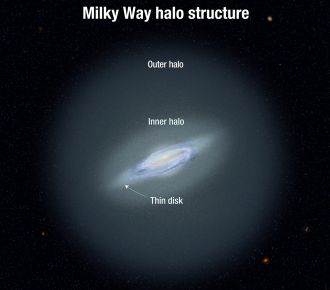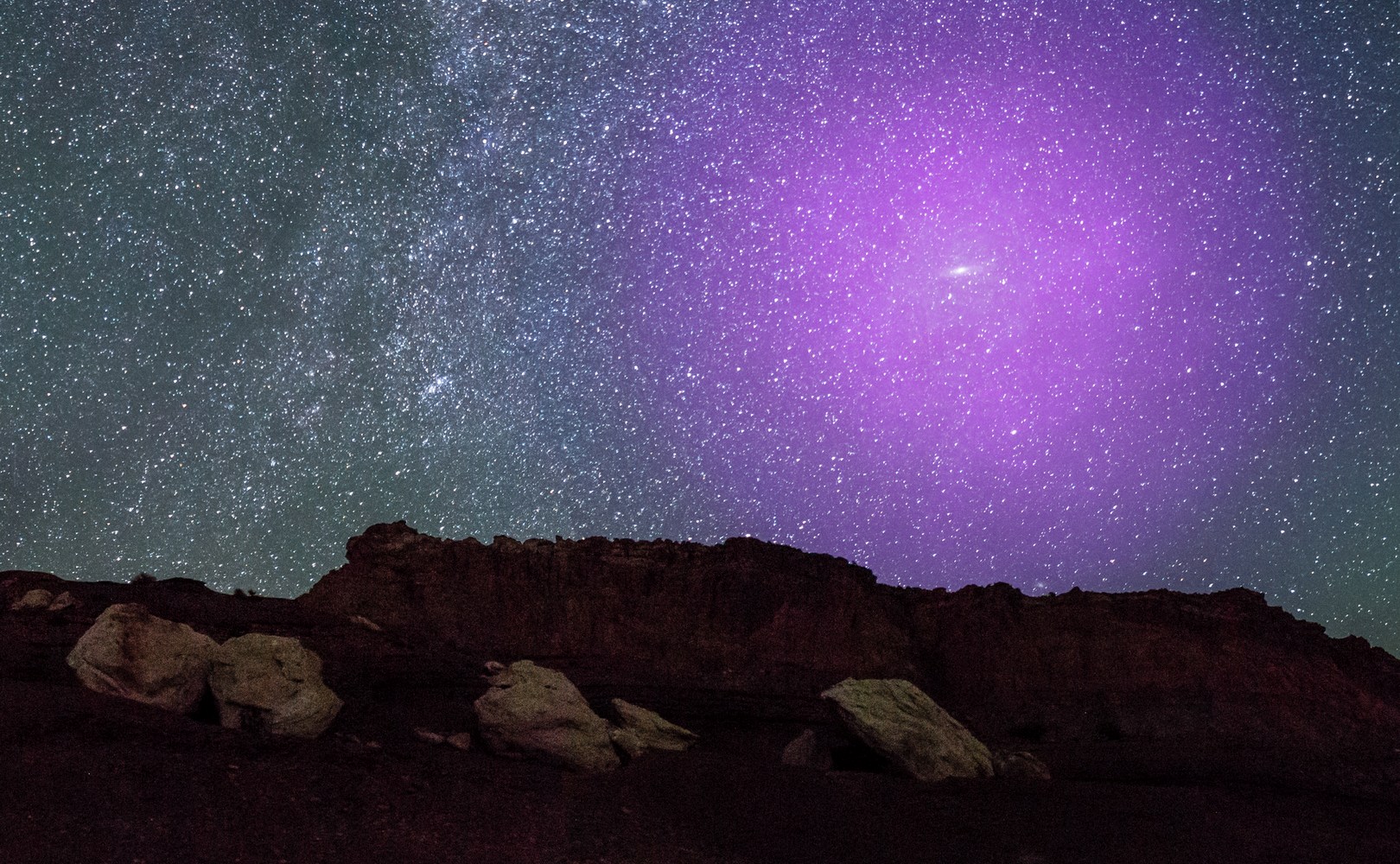How big is the Milky Way, the galaxy we live in? The sun is about 26,000 light-years away from its center. This appears to be the far periphery of the galaxy. However, compared to the distances of the farthest stars, we live roughly in the center.
The Milky Way is a very ancient spiral galaxy, the appearance of which can be well visualized, and even correctly evaluated based on astronomical observations. This is, of course, very common knowledge, except perhaps for age, especially for people who are passionate about astronomy. It has also been apparent for some time that our galaxy has a bar at its center, a feature that characterizes some spiral galaxies. Its existence is confirmed by observations of astronomers from the turn of the millennium.
What can be said about the shape of the galaxy. As a spiral, it is an object in which most of the visible mass is concentrated in a disk. The disk can be divided into a thin disk, a disk with a higher density of stars, and a thicker disk with fewer stars. Inside the thick disk is a thin disk, and in the center of the galaxy there is a strip and the so-called central bulge.
This is how we usually picture the Milky Way as a galaxy seen from a great distance. The spiral arms and the position of the sun relative to the center are marked. (Source: ESA)
This is where we treat as the stark center of the galaxy, where the density of stellar matter is very high. The size of globular star clusters, it is largest near the region where the central supermassive black hole resides.
The central region is about 10,000 light-years across. From the perspective of the size of the Milky Way and the distance of the Sun from its center, which is less than 26 thousand light years, it is not that much, although there are smaller galaxies. Take the Small Magellanic Cloud, where Webb recently photographed a very active star-forming region.
The sun seems very far from the galactic center, but that’s relative
In ancient drawings of the Milky Way, the Sun appears off-centre. A long time ago, when we were just getting used to the concept of a galaxy and the fact that we don’t live in a unique place in space, the Sun in charts was almost at the edge of the galactic disk. Today, when the distance from the center is known, its location is closer. And although there are other arms of the galaxy beyond the sun, we used to think that we occupy a place that can be described as the outskirts of the galaxy.
However, the combination of this belief with the opinion that the Milky Way does not extend farther than that is wrong and I will explain what it is.
The Milky Way’s flat disk is about 100,000 light-years across, but that’s only a fraction of the actual size of our galaxy, the space in which stars and gravitationally bound matter reside.
According to current knowledge, the Milky Way’s thin disk is about 980 – 1,300 light-years thick, and extends about 50,000 light-years from the center. The thick disk extends perpendicular to the plane of the thin disk for several thousand light-years. However, despite the thick disk’s larger size, the thin disk contains the majority of stars, about 95% of the entire galaxy. It is worth noting here that the stars and their companion planetary systems, such as the Sun, do not only inhabit the regions that we designate with arms. The arms are a structure in which the density of matter is highest, and it is here that young and bright stars are formed. But there are also stars in the galactic disk between the arms. And not only there.
The size of the spiral galaxy is not only the size of the visible and impressive disk
The size of a galaxy in terms of its shape may determine the size of the disk visible to an outside observer, but a spiral galaxy, in addition to its disk component, also has an envelope called the galactic halo.
In the halo there is a lot of matter that accumulates in globular clusters, and in the halo there is also dark matter that eludes attempts to accurately detect and characterize it. The galactic disk and central bulge are submerged in the galactic halo, so not only stars far from the disk are included in the halo community. Some of them only pass through the galactic disk, and from measurements of their velocity and direction it can be concluded that they are not stars associated with the galactic disk.

The appearance of the Milky Way. Thin disc, inner halo and outer halo.
Together with the inner halo, the Milky Way-like spiral galaxy is shaped like a thick pebble, slightly flattened in one plane (similar to the shape of earphone shells). On the other hand, the outer halo is theoretically a spherical structure, larger and wider than the galactic disk. Recently, there have been suggestions that the direction of the corona may be slightly different than previously thought, but that’s another story.
Notwithstanding this, there is little luminous matter in the galactic halo, but here it is worth looking out for the single planets, the stars being thrown out from the vicinity of the disk at a very high speed, and also the stars in their orbital motion around the Milky Way moving away from its center some distance the sky. In the halo of the Milky Way, we can distinguish many interesting substructures that look like arms, streams of stars, but arranged at a large angle to the galactic disk.
In fact, they are remnants of past collisions between the Milky Way and smaller neighboring galaxies, and even evidence of processes that are still in progress or have just begun. In the galactic halo, many stars with a small amount of metals (elements heavier than helium) are observed, very old stars that even remember the times when the Milky Way was forming and taking on a spiral shape.
The actual size of the Milky Way, based on the new observations, is very large
From a visual observation perspective, it can be said that the most distant stars in the outer halo of the galaxy place some constraints on the size of the Milky Way. And here the most interesting thing begins, because this size is much greater than the distance of the Sun from the center of the Galaxy. It’s not a double, it’s not a triple. The most distant star recently spotted gravitationally bound to the Milky Way is hundreds of thousands of light-years away, even more than a million light-years away. Some are so far away that they are barely closer to the center of our galaxy on a cosmic distance scale than the center of the neighboring galaxy in Andromeda.
The Milky Way is about 2.5 million light-years away from the Andromeda Galaxy. The most distant stars belonging to our galaxy are found more than a million light-years away. This million is the current estimate for the maximum size of a galaxy, which determines the size of the galactic halo.
These observations show that intergalactic space, although it appears empty compared to the inner regions of galaxies, is not a place where nothing can be found. And just like the stars in the galaxy and orbiting objects such as asteroids and distant comets, which sometimes stream from one system to another, sometimes stars may leave the Milky Way to join Andromeda.
It should also be noted that there are other galaxies in the halo of the Milky Way, including the Large and Small Magellanic Clouds. This does not contradict the above, because the relationship of these satellite galaxies with the Milky Way is obvious, although we still do not know exactly what their past was like.
The most distant stars in the halo of the Milky Way ever discovered. According to the theory
The most distant star in the Milky Way is a group of giant stars, pulsars known as RR Lyrae (named after the progenitor of this type of contrast). Their properties make it possible to ideally correlate the observed brightness and contrast period with the actual distance, making them the so-called standard candles, that is, indicators of distance in space. This is why observations of a group of about 280 stars can be directly related to their distances.
The nearest is 65,000 light-years away, and the farthest is 1,044,000 light-years away, or more than a million light-years away. The location of these outermost stars in the Milky Way, which imposes constraints on the size of the galaxy, confirms modeling results indicating that the outer halo may extend up to 1 million kilometers from the center.
The size of the Milky Way in the course of the collision with Andromeda
You may have already read about the collision of the Andromeda galaxy in a few billion years, which is slowly but surely approaching the Milky Way. And indeed, in a few billion years, a billion years of the basic components of both galaxies will begin to mix. But even today there may be a slow penetration of the outer parts of the Milky Way and the Andromeda Galaxy. Today, these processes are not so violent, but in a few hundred million or a few billion years they will intensify.
There will be forces slowly tearing both galaxies apart, gradually distorting them. And what will come of it, in truth, is the future, which is unlikely to concern us any longer. However, by observing other galaxies in space, we can imagine what the galaxy sometimes referred to as Milkdromeda would be like.
Source: University of California Santa Cruz, inf. Especially

Echo Richards embodies a personality that is a delightful contradiction: a humble musicaholic who never brags about her expansive knowledge of both classic and contemporary tunes. Infuriatingly modest, one would never know from a mere conversation how deeply entrenched she is in the world of music. This passion seamlessly translates into her problem-solving skills, with Echo often drawing inspiration from melodies and rhythms. A voracious reader, she dives deep into literature, using stories to influence her own hardcore writing. Her spirited advocacy for alcohol isn’t about mere indulgence, but about celebrating life’s poignant moments.











